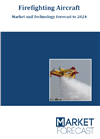DARPA is partnering with the Texas A&M University System’s George H.W. Bush Combat Development Complex (BCDC) to advance capabilities for autonomous wildland firefighting. The initiative will tap key technology developed under the Aircrew Labor In-cockpit Automation System (ALIAS) program, which has successfully designed, developed, and demonstrated the ability to retrofit existing aircraft to enable fully autonomous flight.
"Working together with Texas, we have an opportunity to use autonomous helicopters to completely change the conversation around wildfires from containing them to extinguishing them,” said Stuart Young, DARPA program manager for ALIAS.
In its recently passed two-year budget (FY26-27), the Texas Legislature committed $59.8 million to BCDC to advance the goal of cost effectively saving more lives and property during wildland fires.

Market forecast by Region, Aircraft Type, and Fitment. Country Analysis, Market and Technology Overview including Supply Chains and Critical Raw Materials, Opportunities and Impact Analysis, and Leading Company Profiles
Download free sample pages More information“We see it every year. Texas gets more than its share of disasters, and we at the Texas A&M System promise to continue our work to leverage the latest technologies and innovative ideas to make our great state as safe as possible,” said Glenn Hegar, chancellor of the Texas A&M University System.
DARPA’s Commercial Strategy Office, which works to transition breakthrough technologies to market for both commercial and defense applications, has facilitated resources to support software application development, high-fidelity simulation environments, and testbed integration for using ALIAS to fight wildfires.
“Partnering on a testbed at the state level provides an unparalleled opportunity to rapidly field new technology and ensure outsized impact to Americans both in and out of uniform,” said DARPA Director Stephen Winchell. “The solutions achieved through collaboration with the Bush Combat Development Complex support both economic and national security while demonstrating complex fully autonomous capabilities in challenging real-world conditions.”
The ALIAS automation toolkit, MATRIX, was built and is maintained by Sikorsky as the lead performer on the ALIAS program. In the past year, Sikorsky led proof-of-concept demonstrations of autonomous fire suppression in California and Connecticut using MATRIX and a commercially developed wildfire software solution.
“ALIAS helps us with a manpower problem, since it addresses and augments the pilot availability issues through the optional autonomy. It helps us with safety, because we can fly in more dangerous conditions. It helps us with throughput, because we can get more water on fires by fighting them 24/7, including when they're most vulnerable; the sensors can see through smoke and darkness, so we can fight fires at night,” said Young.
Since ALIAS began in 2013, its autonomy software has been successfully integrated and demonstrated on approximately 20 different platforms, both fixed- and rotary-wing, without any incidents; most of the real-world demonstration time has been on a UH-60A Black Hawk helicopter, culminating with a hands-on demonstration with the previous Secretary of the Army at the controls. The Army is nearly complete with its retrofit of a UH-60L with the MATRIX software and is now exploring autonomy options with the dual-rotor CH-47.
A MATRIX-flown Black Hawk has been used to demonstrate a variety of mission sets, including supply delivery, medical evacuation, and firefighting. The software can be continually updated to add or adapt capabilities as mission needs change.
“In the ALIAS program, we have demonstrated that flight autonomy is technically possible; by partnering with Texas, we can now use this testbed to explore the operational utility of autonomy by demonstrating a dual-use capability," said Young.
The same autonomous tools being validated could be adapted to an array of military or dual-use scenarios, like search and rescue, in response to other disaster and emergency scenarios, rapidly deploying shared resources to meet urgent needs in Texas and around the country.